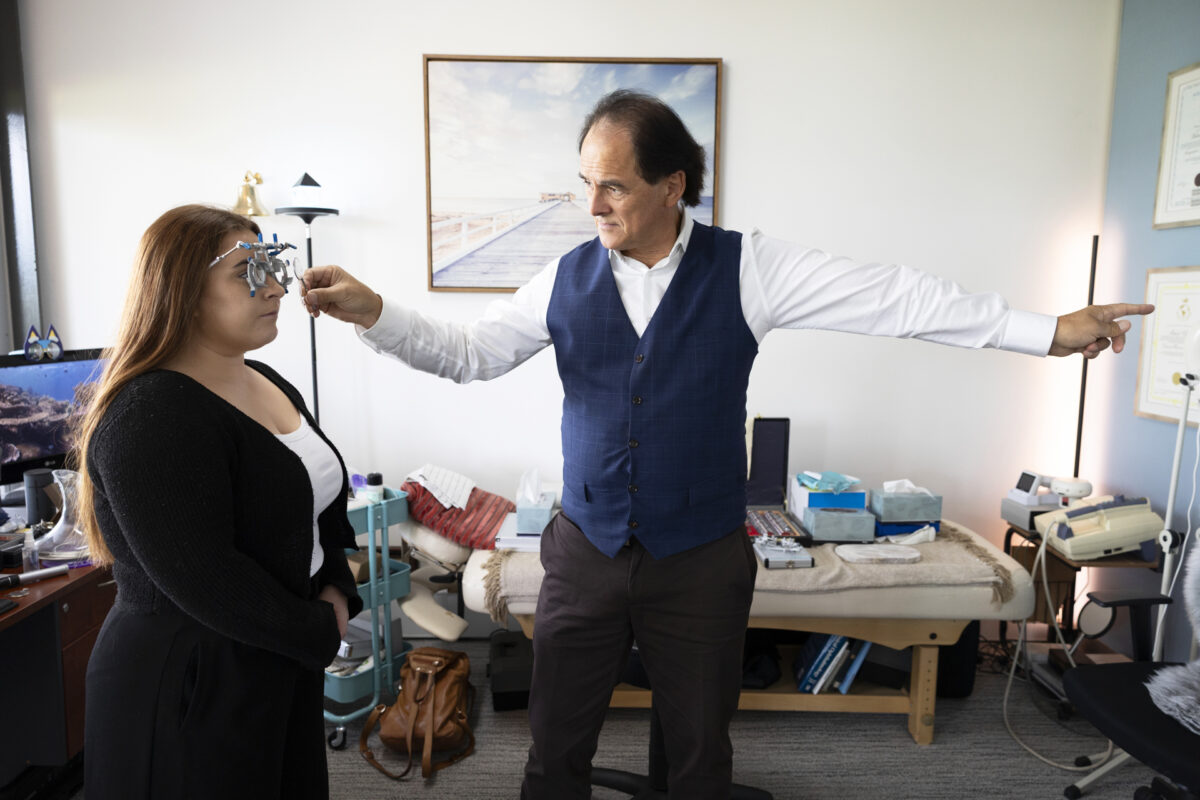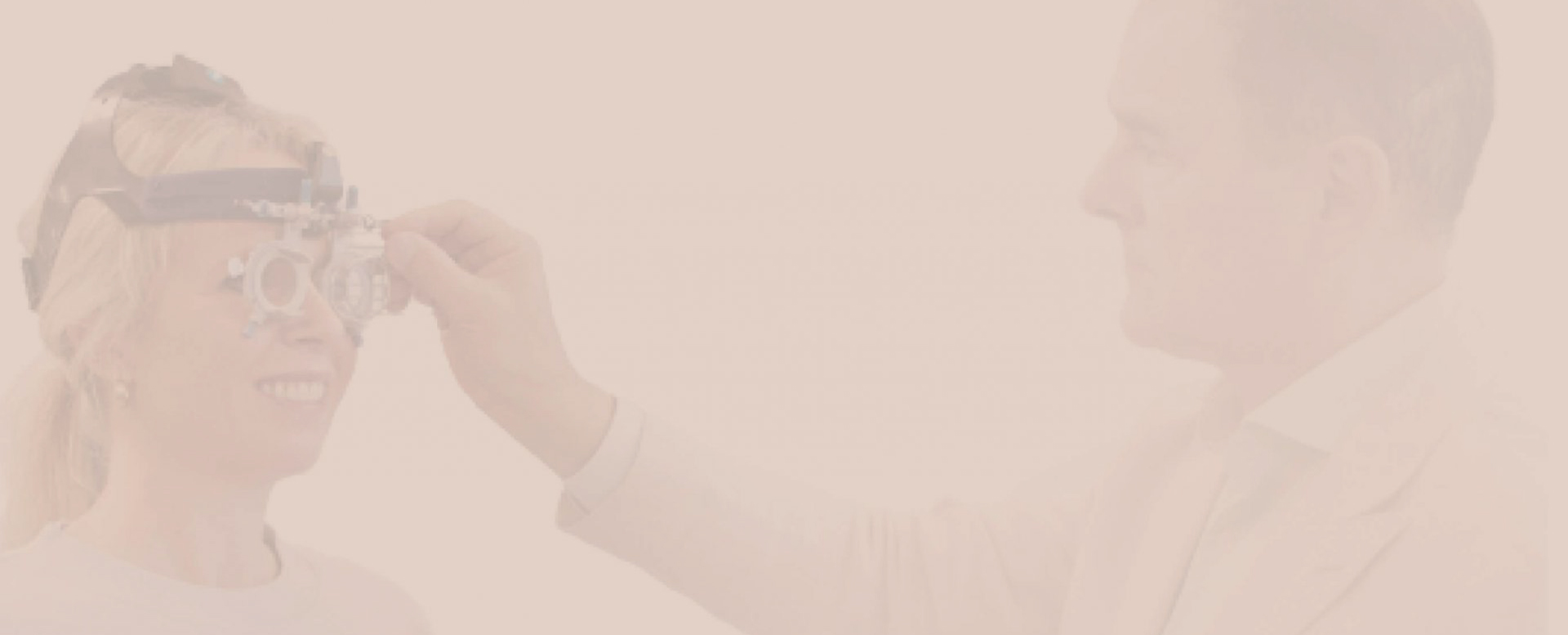BINOCULAR VISION THERAPY
Binocular Vision Training includes testing being primarily done under binocular conditions (two eyes open) with ambient lighting, not isolating the two eyes.
Find Out MoreWHAT IS BINOCULAR VISION THERAPY?

This is the coordination of the two eyes for finer detail and perspective integration to help vision for better perception. It is helping the uptake of information for easier seeing and its various applications in all sorts of activities so that it is maintained in a relaxed, dynamic and healthy state.

BENEFITS OF BINOCULAR VISION THERAPY:
Improved stereoscopic vision
Greater depth perception
Integrated right and left side of the brain
Straightened eyes
Treat amblyopia or lazy eye to become sensorially better aware
Improved reaction times in heightened visual awareness for better sport and working ability


100-DAY MICROPRISM GUARANTEE
Quantum Photo-Somatics is a dynamic process, activating the system to begin rearranging and realigning itself to a state of ease. On average, follow-up consultations resulting in a change of prescription occur on a 6-monthly basis. In most cases this is a decrease of prescription, allowing the system to continue moving forward. Where a prescription has increased, it is an indicator that more support is required at that moment, and will likely come down when conditions change.
However, if your new lenses aren’t delivering the comfort or improvement you expected within 100 days, we’re here for you. We’ll re-evaluate your eyes and make any adjustments that are required.
In the majority of cases, we find that a brief 15-30 minute consult suffices to determine the issue, and is usually a matter of further integration, or a slight adjustment to the prescription. These consultations are available free of charge within the 100 day warranty period.
Progress and Support: In some cases, changes occuring as a result of the process may temporarily create some discomfort. Different stages of progress may require varying levels of support in order to reach the desired outcome.
Consultation Fees: A consultation fee will be charged for consultations extending to an hour or more, given the extensive work involved.
Discounted Lenses: If the outcome of your consultation is a significant decrease of prescription, new lenses will be prescribed at a 30% discount. Lens remakes under warranty are not honored for obvious improvements.
Warranty Lens Remakes: If there’s another significant shift within the next 100 days, we will remake your lenses free of charge.
As the outcomes of this work are highly individual, the application of this policy will have variability depending on the case, and is continually being adapted as the modality itself evolves.

EXPERIENCE THE LATEST IN BINOCULAR VISION THERAPY WITH MICROPRISM VISION
At Microprism Vision, we work at the cutting-edge of developments in behavioural optometry and Quantum Photo Somatics. Our Docklands clinic takes a holistic approach, making full use of the most current technologies for vision therapy for adults and children. We can prescribe glasses and a range of other therapies to help correct your eye condition. Call us today to book in for an eye exam on (03) 9606 0330. Read More
What is Binocular Vision Dysfunction (BVD)?
Binocular vision is something all human beings have, and it’s one of the most common things that can go wrong with our vision. Binocular vision problems come with a variety of symptoms and can have serious effects, but they can also be treated. Microprism Vision is a leading binocular vision provider in Melbourne, here to teach you all you need to know about binocular vision.
Binocular vision is held by animals with two eyes capable of facing in the same direction, including human beings. Using two eyes at once allows us to perceive a single three-dimensional image of our surroundings instead of two eyes producing separate images, because of an overlap between the scene perceived by two eyes. That’s why there is no gap in the middle of our vision! When you have ideally functioning binocular vision your eyes are perfectly aligned and completely synched with each other, so they send one focused picture to your brain. But sometimes, this isn’t the case.
Why Get a BVD Eye Test?
Binocular vision dysfunction (BVD) is a condition affecting the muscles around the eyes, which can become strained and generate a number of uncomfortable symptoms. Binocular vision is caused by a misalignment of the eyes when they fail to coordinate properly, causing overcorrection. Generally, a typical eye exam will fail to detect minute vision misalignments; consequently, BVD often goes undetected or misdiagnosed. Over time, symptoms can change or get worse – cue discomfort or distraction.
What are the Symptoms of Binocular Vision
Here at Microprism Vision, we understand that vision difficulties can harm overall well-being, generating feelings of anxiety, mental clarity and motivation. Some physical signs that binocular vision therapy will be advantageous include eye strain, headaches, compromised depth perception, difficulty comprehending words and double vision (even very occasional).
There are lots of problems associated with binocular vision. Binocular Vision Dysfunction is one of the most common vision problems we get. This happens when our eyes are not coordinated and synched enough, resulting in two images being transmitted to the brain. Because the eyes are in different positions, the images are slightly different. The brain then tries to realign our eyes, which is only temporary and again ends up with misalignment, leading the brain to try to realign again. It’s an endless cycle. Some binocular vision disorders include esotropia and exotropia (cross-eyed or wall-eyed), convergence insufficiency (double vision), refractive (near- or farsightedness in one or both eyes) and strabismic (misalignment of the eyes).
There are lots of disorders and symptoms included under the more general term of Binocular Vision Dysfunction. These issues can lead to difficulties with driving, reading and sleeping and have a negative impact on your life. Symptoms can vary in severity, but a lot of people with binocular vision dysfunction experience anxiety and frustrations regarding their everyday difficulties. Symptoms of Binocular Vision Dysfunction include:
- Strained eye muscles
- Tired and sore eyes
- Headaches
- Facial pain
- Double vision
- Blurred vision
- Dizziness
- Motion sickness
- Light sensitivity
- Poor depth perception
When Might You Need Binocular Vision Dysfunction Treatment?
Unfortunately, the short answer is that there’s no hard and fast rule for knowing when to check for binocular vision dysfunction. Binocular vision dysfunction, or BVD, does not come from a single condition or disorder. Rather, it can come from many different combinations of eyesight conditions, any of which can cause BVD. It’s in much the same way that there’s no singular cause for a stomach ache; you can get one for a dozen reasons.
BVD can affect people who have no other eyesight problems, but it occurs more frequently in people with other conditions. This is especially true a person’s eyes are not evenly affected by the condition. For instance, if you are myopic in one eye but suffer from no disorders in your other eye, the two might become misaligned over time. The same can occur if you have two different conditions, each affecting one eye. For instance, if you are myopic in one eye and have astigmatism in the other, it can lead to BVD. You can also have the same condition affect each eye to a different degree and misalign them. After all, that is essentially what BVD is: It is a misalignment of the two eyes, which forces your brain to interpret two conflicting impressions of your surroundings at all times.
Binocular Vision Dysfunction: The Symptoms
Oftentimes, the easiest way to know if you have BVD is by looking at the list of symptoms. Here are the main ones:
- Dizziness: This is especially true if you suffer from both frequent nausea and motion sickness
- Blurred or double vision unless you are straining your eyes to see clearly
- Frequent or pronounced headaches
- Trouble with depth perception
- A near-constant tilt of the head, which is often the only way to see somewhat well
- Anxiety, especially while handling eyesight-intensive tasks such as driving
Binocular Vision Training is Used to Treat Binocular Vision Problems
You’ll be pleased to know that there are treatments for all these issues. While binocular vision disorders are often misdiagnosed, finding the right professional and getting the correct diagnosis will allow you to get access to a variety of treatments. Binocular vision training is a common method of treating amblyopia, which includes refractive and strabismic issues, also known as lazy eye. Other methods of binocular vision treatment include micro-prism lenses, which are regular eyeglass lenses infused with ground prism, or a pair of reading glasses. There’s a wide range of treatment options available that can help reduce your symptoms and vastly improve your vision.
If you’re experiencing any of the binocular vision symptoms just listed, consult Microprism Vision to discuss your options.
Book a Binocular Vision Dysfunction Test
If you would like to explore what individual benefits binocular vision therapy may be able to offer you, please book a BVD test. Though there are a number of BVD tests recommended by the internet that you can do at home, the only reliable way of diagnosing BVD is by consulting a professional. A BVD eye test delivered by a trained optometrist is quick and painless and is an excellent indicator of what treatment would be most effective for your vision.
The test involves asking a series of questions about your eye health, with a highly specialised test (for both adults and children) that will determine whether you are suffering from BVD. We’ll work closely with you to make sense of the results of the test and how to treat any symptoms found during the test.
As symptoms are likely to worsen over time, if you feel like you could be experiencing BVD, please get in touch to book your test. Read Less
Associations and Registrations






Binocular Vision Dysfunction FAQs
BVD affects a significant number of people, with studies suggesting that as much as 10% of the population may experience some form of binocular vision impairment. Many individuals may not realise that their symptoms could be related to BVD, making it an often underdiagnosed condition.
Treatment for BVD focuses on correcting the eye misalignment and alleviating symptoms:
- Prism Glasses: These special lenses help realign the images each eye sees, simplifying the task for your brain.
- Vision Therapy: Think of this as physical therapy for your eyes, which includes exercises designed to improve coordination between your eyes.
- Surgical Options: In cases where non-invasive methods aren’t sufficient, surgery might be recommended to correct the alignment physically.
Early signs include frequent headaches, blurry or double vision, and difficulties with balance and coordination.
Yes, with appropriate eyewear, therapy, or surgery, most patients see significant improvement.
Absolutely. BVD can affect individuals of any age, including children, often manifesting in difficulties in school, especially with reading and sports.
Making simple changes in your daily life can help manage the symptoms of BVD:
- Use adequate lighting to reduce eye strain.
- Take regular breaks during tasks that require focused vision, such as reading or using a computer.
- Adjust the setup of your work or study area to promote better posture and alignment.
If BVD symptoms are affecting your daily life, it’s crucial to consult with a specialist who can offer a diagnosis and a personalised treatment plan. At Microprism Vision in Melbourne, we are dedicated to helping you achieve optimal eye health through comprehensive care tailored to your unique needs. Don’t let BVD hold you back—contact us today to schedule an assessment and take the first step towards improved vision and quality of life.

HERE’S HOW IT WORKS…
Book In An Eye Test or Tele-Consult
If you’re ready to get started, there are 3 options to choose from. You can schedule a free 360° vision screening test, or you can book a comprehensive Quantum Photo Somatics test of your vision and eye health. If you’re unsure, and you’d like more information – book a free 10-minute, no-obligation telehealth consultation with our team.
We Find Out More About Your Vision
You’ll discuss your vision with our experienced optometrist, then we’ll devise a treatment that’s tailored to your specific needs and vision. This will include the use of Microprism™ lenses and prisms that aim to stop deterioration and improve your eyesight.
Follow Our Treatment Plan
Your new Microprism™ lenses will ‘work out’ your eyes as you wear them. They aim to change the way your eye muscles work, while supporting how your brain processes visual information… an integrative approach that has helped 1,000s of our clients improve their vision and health.
Monitor Results And Adjust Accordingly
The aim of your treatment plan is to improve your eyesight, mind and body function within 6 months – an aim we’re serious about achieving. If there is no improvement after wearing your Microprism™ lenses, we’ll make adjustments and replace your prescription free of charge!

NEED MORE INFORMATION?
TAKE A LOOK AT OUR FAQS
We help a range of vision and other health related problems by redirecting how light is presented to the body. People present with a range of issues including but not limited to:
- Sensitive eyes
- Poor vision
- Frustrated with vision
- Worsening vision
- Balance issues
- Complex issues
- Subconscious issues
- Low energy
- Low motivation
- Vertigo
- Dizziness
- Dyslexia
- Double vision
- Post stroke
- Post accident or injury
- Closed brain injury
- Concussion
- Post trauma
- Depression
- Anxiety
- Emotional stress
- Stress
- Psychological issues
- Physical ailments
- Physical injuries
- Aches and pains
- Mobility issues
- Visual processing
- Performance and learning issues
- Turned eye
- Dry eyes
- Lazy eyes
- Nausea
We take a unique approach to vision and eye health by holistically and dynamically assessing vision, mind and body as a complete unit, working on conscious and subconscious levels.
Our unique methodology, Quantum (Energy) Photo (Light) Somatics (Body Movement) (QPS) has been developed by Dr Michael Christian. QPS supports Optometry and is an endorsed and accredited field with the IICT (International Institute of Complementary Therapies) myiict.com.
It engages a real time integrative feedback system of many factors, making adjustments, counter checks and further adjustments through the process.
Light uniquely and appropriately refracted through lens and prism combinations support and change factors such as breath, posture, balance, muscles, energy, nerves, emotions, movement and body functions, which in turn aims to positively affect the eyes and vision.
Once we understand the wearers profile, we prescribe balanced, highly customised, activating lens and prism prescriptions. These lenses aim to change the way the wearers eye muscles work while supporting how the brain processes visual information.
Just as you work out your body with weights and movement, the glasses we prescribe act as a personal trainer for your eyes that are designed to work just by wearing them, without the hassle of boring and limited time-consuming eye exercises.
The lenses aim to also encourage improvement of health conditions that are linked to, being caused by or exacerbated by poor vision, while aiming to avoid the usual deterioration of vision commonly experienced by long-term glasses wearers. The eyes affect the mind and body, and the mind and body affect the eyes.Both need optimal support. These links and relationships are thoroughly investigated in depth for each person.
Just as good air, food and water provides integral fuel for the body, good light, presented correctly, provides integral fuel for vision and mind.
The function of your eyes has a flow on effect to the rest of your mind and body. Just as changing any nerve or muscle group in the body does.
Microprism integrative prescriptions are derived by focusing two eyes together in specific binocular refractive patterns for clear perspective and detail discrimination. In Microprism progressive lens manufacturing, the prism is located in unique non-traditional active locations to ensure clear, open, comfortable and dynamic vision. Microprism directional prisms (up, down, in and out summations) are located differently and affect eye muscles, changing eye shape and location and the perception of objects within a space. The internal shift on eye muscles via the incoming prism re-directed light, effects and brings into alignment and balance, how near, distance and perspective are observed. This ideal state of alignment brings ease to the optical, motor and sensory system and has a positive flow on effect to the rest of the body. Light feeds the whole biophotonic transduction system of the body.

CHECK OUT OUR INDUSTRY-LEADING
EYEWEAR AND OPTOMETRY SERVICES

NOT SURE IF THIS COULD WORK FOR YOU?
BOOK A FREE QUANTUM VISION TEST
Since 2001, Microprism Vision’s have helped over 9,315 people to improve their vision and eye health, and it can all start with a free 10 minute, Quantum Vision Test!
You’ll try on prism lenses while we test your vision under real world conditions – seated, standing, walking, at a distance, and in close range to a screen and objects. You’ll experience the benefits of prism first-hand!
Book your free test with us today and start your journey to better vision.


